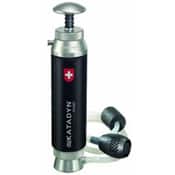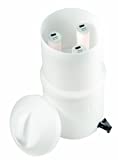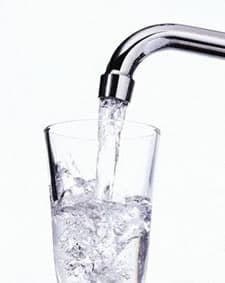 Water is vital to life. Having access to clean, pure water is critical to maintaining health and wellbeing. We all need it in order to survive. But clean water is getting harder to come by. There is constantly more stress and contamination sources being applied to the natural and human built processing systems that supply us with fresh potable water. Water treatment plants go offline when power outages occur. Groundwater and well water sources are being increasingly contaminated. Natural disasters compound the stress on these systems and introduce new hazards and toxic inputs that we once thought were contained and managed. Here are a few recent examples of how our water supplies are being compromised and the potential health risks involved.
Water is vital to life. Having access to clean, pure water is critical to maintaining health and wellbeing. We all need it in order to survive. But clean water is getting harder to come by. There is constantly more stress and contamination sources being applied to the natural and human built processing systems that supply us with fresh potable water. Water treatment plants go offline when power outages occur. Groundwater and well water sources are being increasingly contaminated. Natural disasters compound the stress on these systems and introduce new hazards and toxic inputs that we once thought were contained and managed. Here are a few recent examples of how our water supplies are being compromised and the potential health risks involved.
Recent studies have found statistical links between pesticide use and an outbreak of Parkinson's disease in California farm towns. Researchers even know which chemicals are the likely culprits. What's the government doing about it? Not much.
EPA to Test Well-Water Near Fracking Sites in Pennsylvania
Jan. 6 (Bloomberg) -- Water from wells in a Pennsylvania town near a gas-drilling site that used hydraulic fracturing will be collected and sampled by U.S. regulators after residents complained, the Environmental Protection Agency said.
U.S. EPA will install 30 wells to get a more complete picture of the toxic element's contamination of groundwater.
"For years, Glendale has been studying ways to strip the element from its water. In the meantime, Glendale Water & Power has been blending local water with untainted imports from the Metropolitan Water District of Southern California to ensure that its supplies remain well below contamination limits."
These are just a few of the instances that are getting reported. There are many more examples of where this vital resource is becoming more scarce and unavailable. From droughts plaguing large areas of the country and the over pumping of aquifers and fresh water rivers, our demand is rapidly catching up with our supplies. The threat of peak water (fresh potable water) is becoming a more serious issue of concern.
We never know the worth of water till the well is dry.
~Thomas Fuller
As a follow-on article to the podcast with Jack Keller: Understanding Peak water, and the article by member BSV on Rainwater harvesting, I want to provide an overview of acquiring water in a time of need and steps to take to ensure that it is clean, pure and healthy for you to use and drink.
Essential Questions to ask about Water
There are a number of questions one must ask when evaluating their overall water needs. These questions will address normal everyday access and needs and emergency situations where your resiliency building will come into play.
- What are your sources of drinkable water? (Municipal Supply, Well, Spring, Lake, Rainwater)
- Do you have access to multiple sources of water?
- Is it easy or hard to access / transport that water?
- What is the quality and purity of all your possible sources?
- Do you have a method to ensure your water is drinkable on a daily basis and in emergency situations? (Testing Kit, Purifier, Filtration System)
- How much water do you have available to you in an emergency? (Stored)
- Will you have enough to clean / cook foods you have stored?
- What are your overall water volume needs for all activities? How much do you use? (Cooking, Cleaning, Animal and Garden Needs – for a day, a week, a month, a year)
- What are your community’s plans for water management, access and dealing with emergency situations?
The above list of questions may not be exhaustive in addressing all aspects of getting access to clean water but it should give you a lot to consider if you are just starting to learn about and assess your water preparedness. If you have your water needs and access plan already in place, I hope it has highlighted a few new areas to think about. I welcome any additional questions to be added to make the list more comprehensive and help readers get more insight.
For those of you who are just starting to learn about water resiliency and safeguarding your drinking water, we will explore the main areas of concern when thinking about water access, storage, and quality.
Possible Sources of Water:
Lets first look at where you might be able to get water both on a daily and emergency basis and look at some of the considerations for each source.
- Municipal / City Water Supply
- Natural Water Sources
- Ponds, lakes, streams, springs, rivers, ocean (use desalinators or distillers only)
- Know all local locations before an emergency and check quality.
- Well Water (Shallow or Deep)
- Have non-electric collection options available - hand pumps, special buckets, and solar pumps.
- Bottled - Commercial Delivery
- 6 months to one-year shelf life- Rotate.
- Collection and Emergency Survival Techniques
- Snow, Rainwater Harvesting, Dew Collection.
- Plants, underground sources, moisture collection- get a good survival manual.
- Stored Water (Around the house)
- Pools, spas, waterbeds, hot water heater, toilet tank, hoses, pipes- purify before drinking.
- Specially packaged purified water
- Water in small foil pouches or fruit juice like boxes- 5-year shelf life.
- Large containers
- Food grade plastic, concrete, water bladders, cisterns- above or below ground.
- Small containers
- Food grade plastic- new is best, numerous types available (If previously filled with food or beverage, used containers can impact tastes and odors), glass. Never use container that held chemicals or cleaners.
Water Treatment:
There are many different ways to ensure that your water is clear, clean and safe to drink and use. The various methods below all have pros and cons and the variety of configurations and techniques is numerous. One must evaluate their sources, needs and budget to find the best combination for both the near term and long term goals for water resiliency and access.
Purification vs Filtration
Before we begin to look at making water drinkable, we first have to understand the difference between a water filter and a water purifier.
Water purifiers typically use a chemical treatment to kill any biological threats from a water source. UV light or a mixed-oxidant solution are alternative methods one can use to achieve this goal. Purification eliminates viruses, bacteria and protozoa. Purification will kill all the nasty bugs in the water that will make you sick for a week or so but it does not “filter out” the other unsavory elements that might be in the water that you don’t want to be drinking. These could include chlorine, heavy metals, pesticides, VOC’s and such. A combination of purification and filtration is needed to ensure highly pure drinking water.
Water filters use microfiltration to eliminate water of harmful bacteria and protozoa that are larger than the filter media. Keep in mind that most filters will not filter out viruses, as viruses are typically smaller than pore size of the filter. Filters do eliminate other contaminants you might find in your water and provide a broader level of purity than purification can. So if you are using very dirty or unknown water sources in an emergency, it is best to use a combination of purification and filtration to ensure you’re your water is completely safe biologically.
So depending on you source of water and its quality, the following filter / purify options will provide access to clean and safe potable water. (A combination of purification and filtration may be needed depending on the quality of your pre-treated water.
Purifiers
Designed to remove the bacteria and viruses that can cause sickness and disease from water, purifiers provide a means of treating water for biological pathogens. Below is a few options available. Common bleach can also be used as well for a simple household option when available.
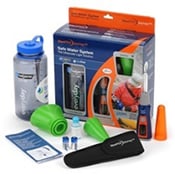 SteriPEN Journey - UV Purifier System
SteriPEN Journey - UV Purifier System
The Journey is the top of the line SteriPEN for purifying water in the outdoors. Using universal symbols, Journey’s LCD screen displays your choice of how much water you want to purify (1/2 or 1 liter), battery status and a countdown timer to tell you when the process is complete and your water is safe to drink. The screen also tracks the number of uses and signals when lamp usage approaches its life limit.
At 8,000 doses, lamp life for the Journey will allow you to purify water for a long time to come. If you purified four liters of water each and every day, your Journey would last almost six years!
The Journey is light, weighing in at just 4.5 ounces (128 grams). And like all SteriPEN models, it’s fast. It takes just 48 seconds to purify 16 ounces (0.5 Liter).
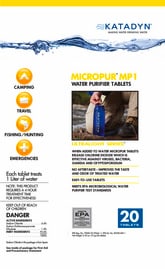 Katadyn Micropur Water Purification Tablets
Katadyn Micropur Water Purification Tablets
Katadyn's Micropur MP1 Chlorine Dioxide tablets are an easy-to-use water purification tablet that is safer than iodine or chlorine. In fact, Micropur MP1 is the only tablet or liquid currently registered by the EPA that controls Cryptosporidium, a waterborne cyst. It is an excellent choice to purify water from lakes, rivers, streams and for international travel.
Portable Microfiltration (Travel, EDC, and smaller scale backup filtration needs)
Effective and easy to travel with though they do take some work filter the water by pumping the water through the filter.
Water treatment products are in high demand for outdoor enthusiasts, international travelers, and relief agencies. Few are better for long-lasting continuous use, however, than the Katadyn Pocket water microfilter. Made of heavy-duty materials, the Pocket features a silver-impregnated ceramic element that's effective against bacteria and protozoa even in extreme conditions. Unlike disposable filters, the ceramic element can be cleaned several times, even in the field. More importantly, the element filters all microorganisms larger than 0.2 microns (0.0002mm), producing clear, drinkable water no matter where in the world you are. The pump also includes an improved, round pump handle for better ergonomics and an outlet hose that attaches to water containers with a single clip.
The Pocket hails from Katadyn's Endurance series, a high-quality line of filters that produce up to 100 times more water than standard water filters. The Pocket is so tough, in fact, that it's the first choice for extreme adventurers like Mike Horn. Plus, it's the only water filter with a 20-year warranty. Other features include a measuring gauge that indicates when you should change the filtering element, a cushioned base that makes it easy to pump on all surfaces, a prefilter, and a carrying bag.
Gravity Microfiltration (Larger Volume Daily Use)
Easy to use and setup. Great for daily use. One draw back on some of these filters is that they do take some pre-charging of the filters before using and need water pressure to get them initially setup.
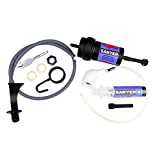 Sawyer PointZeroTwo Purifier with Bucket Adapter Kit with Faucet Adapter
Sawyer PointZeroTwo Purifier with Bucket Adapter Kit with Faucet Adapter
This emergency water purification system is essential to emergency preparedness kits for use during disasters such as floods, hurricanes, and earthquakes. Simply install the compatible purifier to a plastic bucket (not included) and you're setup with a large-volume gravity purification system that can be used to filter hundreds of gallons per day to an incredibly clean .02 Micron standard. Use the included faucet adaptor to drink straight from the tap during boil alerts or in other emergencies when safe drinking water is compromised. This is a great choice for relief agencies or support groups travelling to areas where the water source is compromised or in question, or when you need ultra-pure particle and bacteria filtration. Chemicals and electricity are not required.
Doulton Filter with Two 7-inch Ceramic Candles (Also AquaCera Ceramic Filters)
Royal Berkey with 2 Black Filters and 2 PF-2 Fluoride Filters (Black Berkey Filters)
This filter removes all bacteria, all other little critters, and even a host of noxious chemicals. They can be combined with Arsenic and Fluoride Water Filters and can be setup using a low cost bucket system setup.
Katadyn TRK Drip Gravidyn Water Filter
The Katadyn TRK Drip Gravidyn free-standing gravity filter features a 10 liter water container for large quantities of water. It's ideal for the water supply for camps, cabins and homes without running water. This Gravidyn version comes with three combined ceramic and activated carbon filter elements.
Ceramic filters have a micro porous structure with impregnated silver which delays the growth of bacteria. The pore-size of Katadyn ceramic filters is 0.2 micron (0.0002 mm). Bacteria range in size from 0.2 to 5 micron and, like protozoa (1 to 15 micron), are efficiently filtered out. Ceramic filters can be mechanically regenerated and the filter capacity is measurable.
Activated carbon is used for its ability to reduce harmful organic and inorganic substances in the water. It removes unpleasant tastes, odors, chlorine, pesticides (lindane, DDT) and trihalomethanes (THMs). These substances adhere to the large surface area of the activated carbon. Activated carbon granulate cannot be regenerated.
Reverse Osmosis
Reserse Osmosis systems can provide easy access to under counter or whole house water filtration and purification but keep in mind that they do require water pressure (grid power) to function properly. Note this when developing your overall water plan.
Watts Premier RO-Pure 4-Stage Reverse Osmosis System
This four stage reverse osmosis system consists of a stage 1 five micron Sediment filter that traps particulate matter like dirt, rust, and silt that will affect the taste and appearance of your water. Stage 2 is a five micron Carbon Block filter that helps ensure a greater reduction of chlorine and other materials that cause bad taste and odors (these are called PRE-filters because they filter in front of the reverse osmosis membrane). Stage 3 is the heart of the reverse osmosis system, the RO Membrane. This 50 gallon per day semi permeable membrane will effectively reduce TDS (total dissolved solids), Sodium and a wide range of contaminants such as Lead, Arsenic, Percolate, Chromium, Copper and Radium. It will also remove over 99.95% cysts such as Giardia and Cryptosporidium. The larger production membrane of this state of the art system also means this system has been designed to reduce Nitrates and Nitrites from your drinking water. It is important that this system is properly installed and maintained with a minimum incoming water pressure of 40 psi for it to operate as designed. Stage 4 is a high quality Carbon filter (this is called a POST-filter because it filters after the membrane). The filtered water passes through the membrane and enters the storage tank. When you're ready for a taste, it will leave the storage tank and pass through this fourth stage on its way up to the faucet. The end result? Crystal clear, high quality, and great tasting water!
Establishing a Water Access Plan
It is important to establish a plan of how one will find and make water safe to drink before one needs to actually figure things out in an emergency. Having a plan ensures you have the knowledge, equipment, and issues worked out ahead of time. Here is a basic set of steps to build a plan to meet your water needs.
- Identify at least 2 sources of water
- Determine your water needs/uses and the duration of need anticipated
- Determine Transport, Storage, Treatment Options
- Implement & practice / test your plan and equipment
- Review, expand capabilities and explore community involvement in building water resilience.
Tips and Recommendations:
- A quick and inexpensive way to establish some emergency stored water is to buy 1 or 2 gallon bottled water. A great way to get that first day of supply established.
- It is recommened to have 1 gallon per person per day stored. I try to store 2 gallons per day so we have backup and a little extra to cook and clean with. Doing dishes can always be a challenge with too little water.
- Rotate your stored water on a regular basis and at least every 6 months to a year (Can be used in your garden or on your house plants.)
I hope this article has provided you with a good initial review of water safety and ways in which you can access, make safe and provide clean water in times of emergency and for daily living. I invite you to share your experiences and thoughts in the comments and also on the Definitive Water Thread Discussion.
Cheers to Good Health!
- Jason
This What Should I Do? blog series is intended to surface knowledge and perspective useful to preparing for a future defined by Peak Oil. The content is written by PeakProsperity.com readers and is based in their own experiences in putting into practice many of the ideas exchanged on this site. If there are topics you'd like to see featured here, or if you have interest in contributing a post in a relevant area of your expertise, please indicate so in our What Should I Do? series feedback forum.
If you have not yet seen the other articles in this series, you can find them here:
- Ensuring Access to Safe Drinking Water (jasonw)
- Six Lessons from an Expanding Flock (jasonw)
- Understanding Emergencies: Every Day Carry and Survival Equipment (Aaron Moyer)
- Portable Solar Generators & Hybrid Emergency Backup Systems (chazp)
- Food Storage Packing: Facts and Myths (deniskorn)
- Fibershed: A Case Study In Sourcing Textiles Locally (RebeccaBurgess)
- Honey Bee Candy: Winter Feeding (dps)
- Rainwater Harvesting (BSV)
- Selecting a Greenhouse (jasonw)
- Year-End Tax Steps to Consider (Anthony South)
- Making Fresh Raw Yogurt at Home (jasonw)
- Growing Your Own Potatoes (woodman)
- Considering Data Backup (jasonw)
- Selecting a Firearm (Aaron Moyer)
- The Basics of Growing Garlic (karenbyler)
- Using & About Oxygen Absorbers (deniskorn)
- Vermiculture: Getting down and dirty with worms (jasonw)
- Starting your investment plan (Travlin)
- Getting In Shape: The New Me (cmartenson)
- Slow Money: Getting the “Numb” Out of Numbers (woodytasch)
- Preserving Meat By Curing and Smoking (DanJab)
- Raising Children in Changing Times (DianneM)
- Argentina: A Case Study in How An Economy Collapses (FerFAL)
- Wood Gasification: An Intriguing Emergency Fuel Source (Dutch John)
- Whole Food Eating (Teresa Piro)
- The Case for Small Scale Biofuels (Ready)
- Preparing for Economic Collapse (FerFAL)
- Buying a House in Today's Market (Patrick Killelea)
This is a companion discussion topic for the original entry at https://peakprosperity.com/ensuring-access-to-safe-drinking-water-2/
